Physical Address
304 North Cardinal St.
Dorchester Center, MA 02124
Vomiting/emesis is a protective reflex in response to a variety of stimuli that results in forceful ejection of stomach contents. The emetic reflex is complex and composed of three sequential events. Initially there is a prodromal phase characterized by nausea and autonomic changes, followed by retching and finally vomiting or forceful expulsion of gastric contents through the oral cavity. These events may occur independent of each other. In some cases, nausea may not progress to vomiting, while vomiting may occur without preceding nausea.
Nausea is defined as a vague, unpleasant epigastric or abdominal sensation that presents in a wavelike pattern and is associated with a feeling of imminent vomiting. Nausea is accompanied by a variety of autonomic changes including increases in salivation, diaphoresis, pupillary dilation, tachycardia, and changes in respiration. The gastrointestinal (GI) motor response during nausea comprises inhibition of spontaneous contractions of the GI tract, relaxation of the proximal stomach, and contraction of the esophageal longitudinal muscle, which pulls the lower esophageal sphincter (LES) and proximal stomach into the thoracic cavity. This is followed by a retrograde peristaltic contraction from the small intestine to the gastric antrum called the retrograde giant contraction, which propels duodenal contents into the stomach.
Retching is defined as strong, involuntary efforts to vomit, which may be seen as preparatory maneuvers to vomiting. These efforts consist of spasmodic contractions of the diaphragm and abdominal wall, resulting in increased abdominal pressure and decreased intrathoracic pressure, facilitating the relaxed LES and dilated proximal stomach to slide further into the thoracic cavity. This enables the free flow of gastric content into the esophagus though this material may be returned to the stomach by secondary (nonswallow) esophageal peristalsis resulting in a to-and-fro movement.
Vomiting (emesis) differs from retching in that gastric content is expelled from the mouth. This is fostered by relaxation of the diaphragm and reversal of intrathoracic pressure from negative to positive, leading to increase of intraluminal pressure in the esophagus. It is accompanied by relaxation of the upper esophageal sphincter and closure of the glottis.
Regurgitation is considered a form of gastroesophageal reflux and should be differentiated from vomiting. It is characterized by nonforceful expulsion of gastric content through the oral cavity, and as such, is caused predominantly by transient LES relaxations. It is generally not accompanied by prodromal symptoms or retching. Although apparently effortless, it may be triggered by contractions of abdominal wall musculature as occurs in rumination syndrome. This propulsion perhaps distinguishes regurgitant from nonregurgitant reflux, which remains in the esophagus.
The emetic reflex consists of an afferent limb (receptor and pathway), central integration and control, and an efferent limb (pathway and effector). The diverse afferent pathways may originate within the oropharynx, GI tract, renal system, vestibular system, or central nervous system (e.g., hypothalamus, cortex). These afferent pathways can be triggered by various stimuli including visceral pain and inflammation, toxins, motion, pregnancy, radiation exposure, postoperative states, and unpleasant emotions. Tactile stimulation to the back of the throat can also stimulate emesis. Mechanoreceptors located in the muscularis layer of the GI tract can trigger the emetic reflex in response to passive distension and strong contractions as seen in cases of mechanical obstruction. Chemoreceptors located in the mucosa of the stomach and proximal small bowel can be stimulated by a wide array of chemical irritants and toxins, leading to emesis. Similarly, such receptors can be found in other organ systems such as the pelvic ureteral system, which can induce emesis in response to distension, irritation, and other insults.
The afferent pathways originating from the GI tract are principally mediated via vagal afferent fibers. Vomiting in response to drugs and toxins circulating in the blood is thought to be mediated via the “chemoreceptive trigger zone” in the area postrema located on the dorsal surface of the floor of the fourth ventricle outside the blood-brain barrier. Substances in the blood and cerebrospinal fluid can be detected by chemosensitive receptors in this area. Activation of the afferent limb of the vomiting reflex may also occur through real or apparent motion of the body. This occurs when the brain receives conflicting information about body movement from the visual, vestibular, and proprioceptive systems, referred to as “sensory mismatch.” Higher cortical areas (supramedullary) can also induce vomiting in response to central nervous system diseases and emotional stress via cortical afferent nerves.
The afferent pathways terminate centrally in the nucleus tractus solitarius (NTS) and the surrounding reticular area located in the dorsolateral medulla. The NTS is the beginning of the final common pathway by which all emetic pathways are thought to induce vomiting. The NTS signals to the emetic central pattern generator (CPG). Contrary to past beliefs, there is no isolated central “vomiting center” but rather a group of loosely organized neurons scattered throughout the medulla that need to be activated in an appropriate sequence by the CPG to control the bodily functions associated with emesis. In the final step, the stereotypical motor response of vomiting is generated and is mediated by efferent fibers in the vagal, phrenic, and spinal nerves.
A wide variety of neurotransmitters and neuropeptides are involved in the vomiting reflex. The chemoreceptor trigger zone (CTZ) in the area postrema contains receptors for dopamine (D 2 -receptor), serotonin (5HT-3), histamine (H 1 ), substance P (neurokinin-1 [NK-1]), acetylcholine (muscarinic), and opioid (μ and δ). These receptors are meant to detect the presence of the associated neurotransmitter in the blood and at a certain level will activate the emetic pathway.
Serotonin receptors (5HT-3) are also found in the vagal afferent fibers of the GI tract, and evidence suggests that chemotherapeutic agents, radiation, and noxious stimuli act directly on these GI tract vagal fibers, inducing the release of serotonin. Substance P and its receptor (NK-1) are widely distributed in the central and peripheral nervous system, and blockade of this receptor prevents emesis due to both central and peripheral stimuli. Animal models have demonstrated that physical and psychological stress can trigger the release of corticotropin-releasing hormone, which acts via the CRF-2 receptor located in the brainstem to induce emesis and mediate gastric stasis.
The child’s age is an important guide to the diagnostic possibilities ( Table 15.1 ). While most congenital anomalies of the GI tract present in the neonatal period, others such as antropyloric webs, malrotation, and intestinal duplications may be discovered at any age. Other important etiologies of vomiting to consider in the neonatal period are inborn errors of metabolism and sepsis. Older infants presenting with vomiting may have less severe structural or metabolic disorders, or they may have common acquired disorders such as gastroenteritis, mild systemic infections, gastroesophageal reflux, or allergies. Some metabolic disorders first manifest in older infants when novel dietary introductions expose them to provocative foods. Gastroenteritis and other infections are important considerations in these younger patients with relatively naïve immune systems. Toddlers frequently experience repeated episodes of gastroenteritis due to a variety of infectious organisms. Although gastroenteritis may initially present with emesis, there is usually both vomiting and diarrhea and, depending on the pathogen, abdominal pain. Vomiting in the absence of diarrhea should suggest another etiology. However, this age group also presents with acquired obstructive GI disorders such as intussusception or volvulus or with vomiting caused by ingested poisons.
| Cause | Neonate (<1 mo) | Infant (1–12 mo) | Child (1–11 yr) | Adolescent (>11 yr) |
|---|---|---|---|---|
| Non-GI Infections | ||||
| Otitis media | + | + | _ | |
| Acute or chronic sinusitis | _ | + | + | |
| Streptococcal pharyngitis | _ | + | + | |
| Pneumonitis | + | + | _ | |
| Pyelonephritis | + | + | + | + |
| Meningitis | + | + | + | + |
| Sepsis | + | + | + | + |
| GI Infections | ||||
| Gastroenteritis | + | + | + | |
| Infectious colitis | _ | + | + | |
| H. pylori gastritis | + | + | ||
| Parasitic infection | + | + | ||
| Hepatitis | _ | + | + | |
| Hepatic abscess | _ | + | _ | |
| Anatomic Defects | ||||
| Esophageal | ||||
| Congenital atresia, stricture, webs | + | + | _ | _ |
| Tracheoesophageal fistula | + | + | _ | |
| Vascular ring | + | + | + | |
| Gastric | ||||
| Pyloric stenosis | + | + | _ | _ |
| Antral webs | + | + | + | _ |
| Bezoars | + | + | ||
| Intestinal | ||||
| Stenosis and atresia | + | + | ||
| Webs and duplications | + | + | + | _ |
| Imperforate anus | + | |||
| Meconium ileus | + | |||
| Obstructed inguinal hernia | + | + | + | + |
| Malrotation with volvulus | + | + | + | + |
| Intussusception | + | + | _ | |
| DIOS | + | + | + | + |
| SMA syndrome | + | + | ||
| Duodenal hematoma | _ | + | + | |
| Surgical adhesions | + | + | + | |
| Appendicitis | + | + | ||
| Mucosal Injuries | ||||
| GERD/reflux esophagitis | + | + | + | + |
| Eosinophilic esophagitis | _ | + | + | |
| Gastritis ± H. pylori | _ | + | + | |
| Peptic ulcer or duodenitis | + | + | ||
| Eosinophilic gastritis | + | + | ||
| Celiac disease | _ | + | + | |
| Inflammatory bowel disease | _ | + | + | |
| Ménétrier disease | + | + | ||
| Chronic granulomatous disease | _ | + | _ | |
| Nutrient intolerance (dairy, soy) | + | + | ||
| GI Motility Disorders | ||||
| Achalasia | _ | _ | _ | + |
| Gastroparesis | + | + | ||
| Paralytic ileus | + | + | + | + |
| Hirschsprung disease | + | + | _ | |
| Intestinal pseudo-obstruction | + | + | _ | _ |
| Pancreaticobiliary | ||||
| Cholecystitis | _ | _ | _ | + |
| Cholelithiasis | _ | + | ||
| Choledochal cyst | + | + | _ | |
| Pancreatitis | + | + | ||
| Gallbladder dyskinesia | _ | + | ||
| Intestinal Ischemia/Hypoperfusion | ||||
| Necrotizing enterocolitis | + | _ | ||
| Cardiac defects | + | + | + | _ |
| Mesenteric vessel thrombosis | _ | _ | + | + |
| Endocrine | ||||
| Adrenal hyperplasia | + | + | ||
| Addison disease | + | + | + | + |
| Diabetic ketoacidosis | + | + | ||
| Pheochromocytoma | _ | _ | ||
| Metabolic Disorders | ||||
| Organic acidemia | + | + | _ | |
| Aminoacidemia | + | + | _ | |
| Fatty acid oxidation defects | _ | + | + | |
| Urea cycle defect | + | + | _ | |
| Hereditary fructose intolerance | _ | + | ||
| Mitochondriopathies | _ | + | + | |
| Storage disorders | _ | + | + | |
| Acute intermittent porphyria | _ | + | ||
| Genitourinary Causes | ||||
| Ureteropelvic obstruction | + | + | _ | |
| Renal stones | + | + | ||
| Uremia | + | + | ||
| Pregnancy | + | |||
| Ovarian torsion | _ | + | ||
| Neurologic Causes | ||||
| Hydrocephalus with shunt malfunction | + | + | + | + |
| Arnold-Chiari defect | + | + | _ | |
| Posterior fossa tumors | _ | + | + | |
| Intracranial bleeds | + | + | + | + |
| Concussions | _ | + | + | |
| Pseudotumor cerebri | + | + | ||
| Migraine headaches | + | + | ||
| Abdominal migraine | + | + | ||
| Vestibular disease (motion sickness) | _ | + | ||
| Cyclical vomiting syndrome | + | + | ||
| Miscellaneous | ||||
| Rumination | + | + | ||
| Functional vomiting | + | + | ||
| Eating disorders | + | |||
| Toxic ingestion | _ | + | + | |
| Food poisoning | _ | + | + | |
| Medication-induced | + | + | ||
| Munchausen by proxy (ipecac poisoning) | + | + | ||
Throughout childhood and adolescence, a wide variety of acquired disorders become symptomatic, and more subtle congenital malformations may also first become evident at these older ages. Metabolic disorders continue to be an important but infrequent cause of recurrent vomiting throughout childhood. In adolescents, pregnancy, drug ingestion, chronic marijuana use, and eating disorders should be added to the diagnostic considerations.
Vomiting may be acute or recurrent. The recurrent pattern can be categorized as chronic recurrent or cyclic recurrent ( Fig. 15.1 and Table 15.2 ). Differential diagnoses based on temporal pattern of vomiting are extensive ( Tables 15.3 and 15.4 ). Acute vomiting is the most common pattern encountered in the pediatric population due to the frequent nature of infectious triggers. Acute causes of emesis usually present with multiple episodes of emesis per day, lasting for a few days, and may result in dehydration. This can also be encountered in association with acute GI obstructions, food poisoning, or toxin ingestion as well as an acute rise in intracranial pressure as seen with encephalitis or intracranial space-occupying lesions. The recurrent pattern of vomiting can be chronic, low grade, characterized by one to two episodes of emesis per day. These patients are generally mildly ill and not dehydrated.
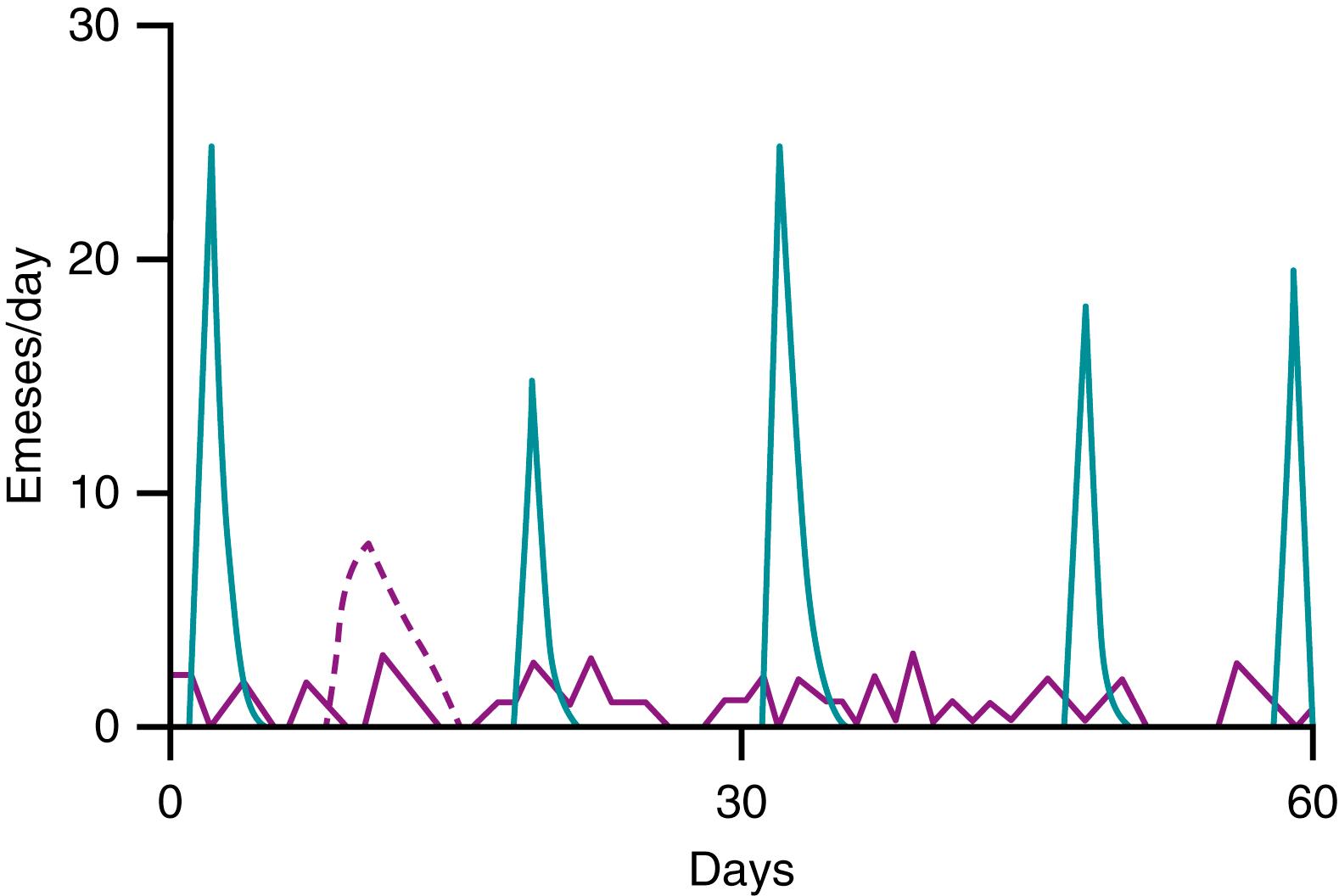
| Clinical Feature | Acute | Chronic Recurrent | Cyclic Recurrent |
|---|---|---|---|
| Epidemiology | Most common | Two thirds of recurrent vomiting cohort | One third of recurrent vomiting cohort |
| Acuity | Moderate-severe, ± dehydration | Not acutely ill or dehydrated | Severe, dehydrated |
| Vomiting intensity | Moderate to high | Low, 1–2 emeses/hr at the peak | High, ∼6 emeses/hr at peak |
| Recurrence rate | No | Frequent, >2 episodes/wk | Infrequent, ≤2 episodes/wk |
| Stereotypy | Unique— if child has had 3 similar episodes, consider cyclic pattern | No | Yes |
| Onset | Variable | Daytime | Early morning |
| Symptoms | Fever, diarrhea | Abdominal pain, diarrhea | Pallor, lethargy, nausea, abdominal pain |
| Household contacts affected | Usually | No | No |
| Family history of migraine headaches | 14% positive | 82% positive | |
| Causes | Viral infections | Ratio of GI to extra-GI causes 7:1; upper GI tract mucosal injury most common (esophagitis, gastritis) | Ratio of extra-GI to GI causes 5:1; cyclic vomiting syndrome most common (also hydronephrosis, metabolic) |
| Category | Acute | Chronic | Cyclic |
|---|---|---|---|
| Infectious | Gastroenteritis ∗ Otitis media ∗ Streptococcal pharyngitis Acute sinusitis Hepatitis Pyelonephritis Meningitis |
Helicobacter pylori ∗ Giardiasis Chronic sinusitis ∗ |
Chronic sinusitis ∗ |
| Gastrointestinal | Inguinal hernia Intussusception Malrotation with volvulus Appendicitis Cholecystitis Pancreatitis Distal intestinal obstruction syndrome |
Anatomic obstruction GERD ± esophagitis ∗ Eosinophilic esophagitis ∗ Gastritis ∗ Peptic ulcer or duodenitis ∗ Achalasia SMA syndrome Stricturing Crohn disease Rumination Functional |
Malrotation with volvulus Cyclic vomiting syndrome ∗ |
| Genitourinary | Pyelonephritis UPJ obstruction |
Pyelonephritis Pregnancy Uremia |
Acute hydronephrosis secondary to UPJ obstruction |
| Endocrine, metabolic | Diabetic ketoacidosis | Adrenal hyperplasia | Diabetic ketoacidosis Addison disease MCAD deficiency Partial OTC deficiency MELAS syndrome Acute intermittent porphyria |
| Neurologic | Concussion Subdural hematoma Encephalitis Migraine |
Arnold-Chiari malformation Subtentorial neoplasm |
Abdominal migraine ∗ Migraine headaches ∗ Arnold-Chiari malformation Subtentorial neoplasm Metabolic encephalopathy |
| Other | Toxic ingestion Chronic marijuana use: hyperemesis syndrome Food poisoning |
Bulimia Pregnancy |
Factitious disorder by proxy (e.g., ipecac poisoning) |
| Temporal Associations | Diagnosis | Other Clues |
|---|---|---|
|
Increased intracranial pressure Sinusitis with postnasal mucus Pregnancy Uremia |
Headache, papilledema Sinus tenderness Secondary amenorrhea |
|
||
|
Peptic ulcer disease, reflux | Epigastric pain, heartburn |
|
||
|
Hereditary fructose intolerance | Hypoglycemia |
|
Galactosemia | Cataracts |
|
Metabolic inborn error | Hyperammonemia, acidosis |
|
||
|
Cow’s or soy milk intolerance | Stool guaiac positive |
|
Gluten-sensitive enteropathy (celiac) | Failure to thrive |
|
Miscellaneous allergic, eosinophilic gastroenteropathies | History of asthma, hives, ↑ eosinophils, family history of allergies |
|
||
|
Gastric stasis/obstruction | Distention, tympany |
|
Metabolic disease | See Table 15.8 |
|
||
|
Post-tussive | Respiratory disease |
|
Recurrent gastroenteritis | Fever, diarrhea, sick contacts |
|
Motion sickness | Nystagmus Vertigo |
|
Ureteropelvic junction obstruction (“Dietl crisis”) | Spontaneous resolution with normal hydration |
|
Dysmenorrhea associated Acute intermittent porphyria Pelvic inflammatory disease |
Relief with NSAIDs Nonperitonitis pain, distention, tachycardia, constipation Vaginal discharge |
|
Local GI irritation: NSAIDs, ingested poison CTZ stimulation: chemotherapeutics, opioids, ipecac Steroid withdrawal: adrenal crisis Drug-induced pancreatitis, hepatitis Drug-precipitated acute intermittent porphyria |
Ipecac abuse in anorexia History of L-asparaginase, valproate, isoniazid, etc. Oral contraceptives, sulfa drugs, barbiturates |
|
See Table 15.3 | See Table 15.2 |
About 30% of recurrent emesis manifests with a cyclic pattern as in cyclic vomiting syndrome (CVS) . This presents with intermittent episodes of high-frequency vomiting interspersed with periods of normal health. Episodes are often stereotypical and associated with pallor, listlessness, and dehydration. In those with a chronic emesis pattern, the GI causes exceed the non-GI causes by 7:1. The most common etiologies of chronic emesis include GI mucosal inflammation or defects such as eosinophilic esophagitis, gastritis, peptic ulcer disease, and Crohn disease, but psychobehavioral causes such as rumination and bulimia nervosa should be kept in mind. On the contrary, the diagnostic profile of cyclic vomiting is reversed with a ratio of non-GI causes outnumbering GI causes by 5:1. While CVS is the most common cause of this pattern, an episodic pattern of vomiting can also be a manifestation of renal (e.g., acute hydronephrosis from ureteropelvic obstruction), endocrine (e.g., diabetic ketoacidosis, Addison disease), or metabolic disorders (e.g., mitochondrial, fatty acid oxidation defects).
The contents of the vomitus narrow the diagnostic possibilities. Hematemesis and bilious vomiting, in particular, are approached in a manner very different from that of vomiting without these characteristics and may represent more serious underlying disorders (see Chapter 16 ). Effortless vomiting is witnessed in reflux and rumination, while more forceful vomiting is often noted with upper GI tract obstruction, CVS, and toxins.
Temporal associations of vomiting with specific time of the day, relation to meals, intake of specific foods, and other inciting events can give important diagnostic clues (see Table 15.4 ). Of all the causes of early morning emesis, the most worrisome is increased intracranial pressure. More common causes of early morning nausea and vomiting are CVS, dysautonomia, and chronic sinusitis with postnasal drip. Pregnancy should be ruled out in all sexually active females . Post-tussive emesis should direct diagnostic attention to the cause of the cough itself. Food vomited many hours after its consumption is suspicious for delayed gastric emptying or gastric outlet obstruction. Episodic vomiting associated with abdominal pain precipitated after consumption of a large quantity of fluids and resolving after diuresis can be a result of intermittent hydronephrosis caused by ureteropelvic junction (UPJ) obstruction.
Associated symptoms ( Table 15.5 ) can be crucial in differentiating serious life-threatening conditions that require urgent intervention from the more benign causes of vomiting. Vomiting with neurologic signs such as headache, altered sensorium, and seizures should alert providers to consider intracranial or metabolic disorders. Abdominal pain is a central symptom associated with vomiting and its character and location can further help narrow the diagnosis (see Chapter 13 ). Abdominal pain can be categorized as visceral, parietal, or referred pain. Visceral pain is caused by excessive contraction, distension, inflammation, or ischemia of the walls of hollow viscera (stomach, intestines, bile duct, ureter) or the capsule of solid organs (liver, spleen, kidney). Patients usually have difficulty describing visceral pain. It can be dull, intermittent, vague, or colicky and is poorly localized, often to the midline. Common examples are pain secondary to infectious gastroenteritis, functional abdominal pain disorders, toxic irritation, intestinal obstruction, etc. Parietal pain is sharp, constant, and well localized to the area of the underlying problem. It signifies inflammation of the contiguous peritoneum. It is exacerbated with movement, is associated with localized tenderness on examination, and requires immediate medical attention. Parietal pain is present in conditions such as acute cholecystitis, pancreatitis, appendicitis, and perforation of viscus. Referred pain describes pain perceived in an area remote from the site of the inciting pathologic process. Abdominal pain may therefore be a symptom of disease localized in the thorax, pelvis, or retroperitoneum.
| Associated Symptom or Sign | Diagnostic Consideration |
|---|---|
| Systemic Manifestations | |
| Acute illness, dehydration | Infection, ingestion, cyclic vomiting, possible surgical emergency |
| Chronic malnutrition | Malabsorption syndrome |
| Gastrointestinal Symptoms | |
| Nausea | Absence of nausea can suggest increased intracranial pressure |
| SubsternalEpigastricRight upper quadrantLeft upper quadrantPeriumbilicalRight/left flankRight lower quadrantLeft lower quadrant | EsophagitisUpper GI related (reflux, gastritis, PUD), pancreatitisHepatitis, cholecystitis, pancreatitis, cholelithiasis, biliary colic, right lower pneumonia, right pyelonephritisPUD, pancreatitis, splenic enlargement, left lower lobe pneumonia, left pyelonephritisNonspecific, small bowel obstructionUPJ obstruction, renal stones, pyelonephritis, adrenal hemorrhageAppendicitis, right tubo-ovarian diseaseSigmoid related, left tubo-ovarian disease |
| Diarrhea | Gastroenteritis, bacterial colitis |
| Constipation | Hirschsprung disease, pseudo-obstruction, hypercalcemia, hypokalemia, lead poisoning, porphyria |
| Dysphagia | Eosinophilic esophagitis, achalasia, esophageal stricture |
| Malodorous breath | H. pylori |
| Jaundice | Hepatitis, cholecystitis, hepatobiliary obstruction |
| Visible peristalsis | Gastric outlet obstruction |
| Surgical scars | Surgical adhesions, surgical vagotomy |
| Succussion splash | Gastric outlet obstruction with gastric distention |
| Bowel sounds | Decreased: paralytic ileus; increased: mechanical obstruction |
| Severe abdominal tenderness with rebound | Perforated viscera and peritonitis |
| Abdominal mass | Pyloric stenosis, congenital malformations, Crohn disease, ovarian cyst, pregnancy, abdominal neoplasm |
| Neurologic Symptoms | |
| Headache | Allergy, chronic sinusitis, migraine, increased intracranial pressure |
| Postnasal drip, congestion | Allergy, chronic sinusitis |
| Vertigo | Migraine, inner ear disease |
| Seizures | Epilepsy |
| Abnormal muscle tone | Cerebral palsy, metabolic disorder, mitochondrial disorder |
| Abnormal funduscopic exam or bulging fontanel | Increased intracranial pressure, pseudotumor cerebri |
| ENT Symptoms | |
| Postnasal drip, congestion | Allergy, chronic sinusitis |
| Sore throat, ear pain | Streptococcal pharyngitis, acute otitis media |
| Cardiac Symptoms | |
| History of valvular disease | Mesenteric arterial thrombosis/emboli |
| Hypotension | Intestinal ischemia, mesenteric arterial thrombosis/emboli |
| Hypertension | Porphyria, some variants of cyclic vomiting syndrome |
| Renal Symptoms | |
| Dysuria, hematuria, renal hypertension | Pyelonephritis, calculi, hydronephrosis |
| Gynecologic Symptoms | |
| Menstrual irregularity | Pregnancy, ectopic pregnancy |
| Vaginal discharge | Pelvic inflammatory disease |
| Menses associated | Porphyria, endometriosis, dysmenorrhea |
| History of Head Trauma | Concussion, intracranial hemorrhage |
| History of Abdominal Trauma | Duodenal hematoma |
| Family History and Epidemiology | |
| Peptic ulcer disease | Peptic ulcer disease, H. pylori gastritis |
| Migraine headaches | Abdominal migraine, cyclic vomiting syndrome |
| Contaminated water | Giardia , Cryptosporidium , other parasites |
| Travel | Traveler’s ( Escherichia coli ) diarrhea, giardiasis |
When suspecting a psychosocial cause of vomiting, providers should inquire about anxiety, binge eating, body image, and any recent stressors. Minor head injury can also present as vomiting in children, especially toddlers. There is evidence to suggest that vomiting after a minor head injury may be related to intrinsic patient factors rather than the severity of the injury. Vomiting that is persistent or latent in onset may be more likely to signify head injury. Emesis following a recent history of blunt abdominal trauma should raise the suspicion of a duodenal hematoma.
Previous surgery, hospitalizations, and medications may provide important clues. A family history of fetal or neonatal deaths suggests a genetic or metabolic cause; similar illness in family members or other contacts may suggest infections or common toxic exposures. Psychosocial stressors may be found in adolescents with bulimia, peptic ulcer disease, chronic marijuana use, or intentional self-poisonings.
Although vomiting is a “gastrointestinal” symptom, it can be a manifestation of disease in multiple systems of the body (see Table 15.5 ). Vital signs identify fever, which is important in narrowing the differential diagnosis. Tachypnea may signify pneumonia or a metabolic acidosis, which is seen with vomiting from inborn errors of metabolism or poisoning. Intense vomiting as seen with infection, toxin ingestion, cyclic vomiting, or a possible surgical emergency can present with signs of severe dehydration or hypovolemic shock. Presence of failure to thrive or chronic malnutrition can be suggestive of malabsorption syndromes or metabolic conditions. A thorough neurologic exam including examination of optic fundi is warranted in all patients. The absence of venous pulsations or sharp optic disc margins may be the only evidence of a brain tumor or other intracranial lesion causing vomiting. When in doubt, a formal ophthalmologic examination is warranted.
Simple observation of operative scars may suggest the possibility of obstruction from intestinal adhesions, and visible distention may represent ascites caused by liver disease or intraluminal distention caused by intestinal obstruction or ileus. The order of the examination is important because auscultation performed after stimulation of intestinal motility by palpation may artifactually change the auscultatory findings. An important distinction in the vomiting child is whether bowel sounds are increased, as in gastroenteritis or in bowel obstructions, or absent, as in ileus caused by peritonitis or in chronic intestinal pseudo-obstruction. Increased bowel sounds resulting from luminal obstruction are often characterized by intermittent “rushes” of high-pitched sounds that are coordinated with episodes of colicky pain. Although seen infrequently, visible peristalsis in infants and a succussion splash in children are indications of a gastric outlet obstruction that is causing gastric distension and retention of fluid. Palpate the abdomen and pelvis for area of tenderness and signs of peritoneal inflammation as they often represent disorders necessitating further imaging and/or surgery. Also palpate for presence of organomegaly and abdominal masses. Hepatosplenomegaly can be found in various metabolic or inflammatory diseases. Abdominal masses can be congenital (e.g., mesenteric cyst) or acquired (e.g., neuroblastoma) and result in bowel obstruction (see Chapter 20 ). Examine genitalia and hernia sites for ambiguous genitalia, ovarian/testicular torsion, and strangulated hernias. Vague periumbilical pain is quite nonspecific, but the localized, very sharp pain signifying inflammation of the peritoneum requires immediate attention. Initial luminal obstruction may progress to ileus as peritonitis intervenes. Localization of nonperiumbilical pain or tenderness helps a great deal in determining the diseased intraabdominal organ (see Table 15.5 ).
A rectal examination may be helpful in the vomiting child as the presence and consistency of rectal stool may be determined. A large fecal impaction may possibly contribute to vomiting in some young children. Pelvic masses and tenderness identified by rectal exam may represent appendicitis, ovarian torsion, or pelvic inflammatory disease. The stool should always be tested for blood and should be considered for testing for pH, reducing substances, fat, leukocytes, and infectious organisms, depending on the presentation.
The evaluation of a patient with vomiting is usually performed in a primary care or emergency department setting. Initial evaluation is directed at assessment of airway, breathing, and circulation as well as hydration status. Clinically diagnosed dehydration without any laboratory confirmation is usually a sufficient basis to initiate rehydration therapy. Look for the presence of red flag signs ( Table 15.6 ) that suggest more ominous causes of vomiting. If the physical examination reveals signs of acute abdomen (bilious emesis, peritonitis, shock), obtaining abdominal imaging and seeking urgent surgical consultation are indicated. Presence of brisk hematemesis warrants an urgent gastroenterology consult. Altered mental status suggests toxin ingestion, inborn errors of metabolism, acquired metabolic conditions such as hyperammonemia, diabetic ketoacidosis, and neurologic causes.
|
Well-appearing infants with typical regurgitant reflux usually require no laboratory evaluation, except possibly a GI contrast study if they do not respond readily to conservative therapy (see later discussion). Similarly, a single, brief episode of mild vomiting with no suggestion of dehydration or other complications may necessitate no laboratory studies. Most children with presumed infectious gastroenteritis or colitis do not need to undergo microbiologic stool testing to identify underlying pathogens since these are self-limiting conditions. Other children, those with severe acute vomiting or with chronic or recurrent vomiting, should have screening studies of blood or urine ( Table 15.7 ). Presence of glucose and ketones in urine suggests diabetic ketoacidosis; red blood cells suggest a renal cause (nephritis, Henoch-Schönlein purpura, renal calculi, or trauma); and leukocytes or nitrites suggest a urinary tract infection. Screening blood investigations should include a total blood count, blood sugar, serum electrolytes, blood gases, liver enzymes, lipase, and renal function tests. Elevated leucocyte count suggests presence of infection or inflammation; anemia could be secondary to chronic malabsorption, occult GI losses, or a hemolytic process such as hemolytic uremic syndrome. Typical electrolyte abnormalities occur in an infant with projectile vomiting from pyloric stenosis (hypochloremic, hypokalemic metabolic alkalosis) and congenital adrenal hyperplasia or Addison disease (hyperkalemia and hyponatremia). Blood and urine screening for several metabolic disorders are positive only during an actual vomiting episode; therefore, when suspecting a metabolic cause, attempts should be made to obtain specimens at these times, which may increase the diagnostic yield. Metabolic work-up includes acid-base, serum ammonia and lactate, serum and urine carnitine (possible fatty acid oxidation defect), serum amino acids (possible aminoacidemia), urine organic acids (possible organic acidemia), and urine aminolevulinic acid and porphobilinogens (possible acute intermittent porphyria) ( Table 15.8 ).
| Laboratory Test | Possible Significance |
|---|---|
| CBC |
|
| Electrolytes, glucose, BUN, creatinine |
|
| Pancreatic enzymes (amylase, lipase) |
|
| Liver enzymes (ALT, AST, ALP, GGT) |
|
| Metabolic work-up (blood gas, ketones, ammonia, lactate, pyruvate, amino acid, organic acid, carnitine, acylcarnitine, porphobilinogen deaminase, toxicology) |
|
| Urine (microscopy, culture, β-HCG, reducing substance, ketones, amino acid, organic acid, toxicology, porphobilinogen, δ-ALA) |
|
| Nutritional abnormalities | Failure to thrive, anorexia |
| Dietary provocations | Fructose, galactose, protein, fasting |
| Neurologic abnormalities | Lethargy, coma Tone ↑ or ↓, developmental delay Seizures |
| Liver abnormalities | Hepatosplenomegaly Jaundice |
| Respiratory abnormalities | Apnea Hyperpnea (caused by metabolic acidosis or hyperammonemia) |
| Odd odors (breath, urine, ear wax) | Cabbage: tyrosinemia Sweaty feet: isovaleric acidemia Musty: phenylketonuria, hepatic coma (fetor hepaticus) Fruity: ketones (many, nonspecific) Maple syrup: maple syrup urine disease Other: 3-methylcrotonyl-CoA carboxylase deficiency Multiple carboxylase deficiency Acyl-CoA dehydrogenase deficiency Putrid: sinusitis Alcohol: alcohol ingestion |
| Miscellaneous abnormalities | Eye abnormalities (cataracts) Hair abnormalities (fragile) Pigmentation of skin (“tan”) and mucosa Adrenal calcifications Ambiguous genitalia Cardiomyopathy Family history of fetal or neonatal deaths; consanguinity |
| Screening study abnormalities | Metabolic acidosis Hypoglycemia (hyperketonuric or hypoketonuric) Hyperkalemia (with hyponatremia) Hyperammonemia Hypertransaminasemia Anemia, leukocytopenia, thrombocytopenia Urinary non–glucose-reducing substance Urinary Fanconi syndrome |
If the history and physical examination suggest the possibility of abdominal disease, endoscopic evaluation or abdominal plain films (including a second image such as an upright film) are usually warranted ( Table 15.9 ). Endoscopy is particularly useful in hematemesis, in suspected peptic ulcer disease, or when tissue is needed for histologic study (e.g., establishing a diagnosis of Helicobacter pylori gastritis or of eosinophilic gastroenteropathy). Radiographic testing is useful in most other situations. Further evaluation, such as contrast studies, ultrasonography, CT, or MRI, is tailored to the suspected diagnoses. In some cases, manometric evaluation is prompted by the suggestion of GI motility disorders, such as achalasia and chronic intestinal pseudo-obstruction.
| Test | Findings | Possible Significance |
|---|---|---|
| Imaging | ||
| Plain abdomen (supine, upright) | Multiple air fluid levels | Bowel obstruction, ileus |
| Distended bowel loops | Ileus | |
| Double bubble | Duodenal atresia | |
| Calcifications | Biliary, renal stones, appendicitis | |
| Free air | Intestinal perforation | |
| Free fluid | Ascites | |
| Foreign bodies | ||
| Organomegaly, masses | ||
Contrast study (barium or Gastrografin)
|
Malrotations, obstructions Distal obstructions Intussusception, obstructions |
Therapeutic: intussusception, meconium ileus, DIOS |
| Ultrasonography | Mass, cyst, abscess, pyloric stenosis; hepatobiliary, pancreatic, urinary, gynecologic lesions | |
| CT/MRI abdomen | Mass, cyst, inflammatory lesions, hepatobiliary, pancreatic, urinary, gynecologic lesions | |
| MRI/CT head | CNS lesions | Neurogenic vomiting |
| Endoscopy | ||
| Upper | ||
| Diagnostic | Obstruction, hemorrhage, Giardia or Helicobacter pylori infection | |
| Therapeutic | Hematemesis | |
| Lower | ||
| Diagnostic | Distal obstruction, infection | Obstruction, infection |
| Therapeutic | Sigmoid volvulus | |
| Manometry | ||
| Esophagus | Failure of sphincter relaxation | Achalasia |
| Dysmotility | Esophageal dysmotility | |
| Small bowel | Dysmotility | Pseudo-obstruction |
| Rectum/colon | Failure of sphincter relaxation | Hirschsprung disease |
| Dysmotility | Pseudo-obstruction | |
Cardinal symptoms or signs accompanying the vomiting direct the differential diagnosis. When vomiting is a result of intraabdominal disease, it is useful to define whether obstruction, dysmotility, inflammation, or ischemia is the mechanism. Abdominal pain, which frequently accompanies vomiting, can suggest both the type of disorder and the organ involved (see Table 15.5 ). Symptoms referable to non-GI organ systems direct attention to those systems. For example, accompanying neurologic symptoms may direct attention to central nervous system disorders, metabolic disease, poisonings, or psychobehavioral disease.
Esophageal strictures or obstruction produces dysphagia with welling up or drooling of oropharyngeal secretions or esophageal contents rather than actual vomiting; the material is undigested. Respiratory symptoms from aspiration may be prominent.
| Esophagus | |
| Congenital | Esophageal atresia (with or without fistula) Isolated esophageal stenosis Duplication Vascular ring |
| Acquired | Caustic agent esophageal stricture Inflammatory stricture: peptic, EOE Achalasia |
| Stomach | |
| Congenital | Antral webs |
| Acquired | Pyloric atresia ∗ Bezoars/foreign body Pyloric stenosis Pyloric stricture (ulcer) Crohn disease Eosinophilic gastroenteropathy Prostaglandin-induced pyloric stenosis Chronic granulomatous disease |
| Small Intestine | |
| Congenital | Intestinal atresia Annular pancreas Malrotation/volvulus Duplications Meconium ileus Obstructed inguinal hernia |
| Acquired | Postsurgical adhesions or strictures Crohn disease (stricture) Intussusception Duodenal hematoma (abuse, trauma) Meconium ileus equivalent (DIOS) Superior mesenteric artery syndrome |
| Colonw | |
| Congenital | Meconium plug Hirschsprung disease Colonic atresia, stenosis Rectal stenosis Imperforate rectum/anus Malrotation/volvulus Small left colon syndrome (IDM) |
| Acquired | Ulcerative colitis (toxic megacolon) † Crohn disease (stricture) Postsurgical adhesions or strictures |
Esophageal atresia is a congenital malformation defined by the discontinuity of the esophagus. Infants present at birth with a prenatal history of polyhydramnios and intolerance of initial feeding. The esophageal atresia is accompanied by a distal tracheoesophageal fistula (TEF) in 85% of cases, by a proximal fistula in a small percentage, and by no fistula in the remainder ( Fig. 15.2 ). Esophageal atresia is associated with other anomalies in 15–50% of patients; cardiac, anorectal, and genitourinary defects are most common. Ten percent of all esophageal atresia patients and 25% of those without a fistula have the VATER or VACTERL (vertebral, anorectal, cardiac, tracheoesophageal, renal, radial, limb) association. As many as 33% of affected infants are premature. Diagnosis can usually be made by plain films after passage of an opaque rubber catheter, which coils in the upper pouch ( Fig. 15.3 ). Treatment is surgical.

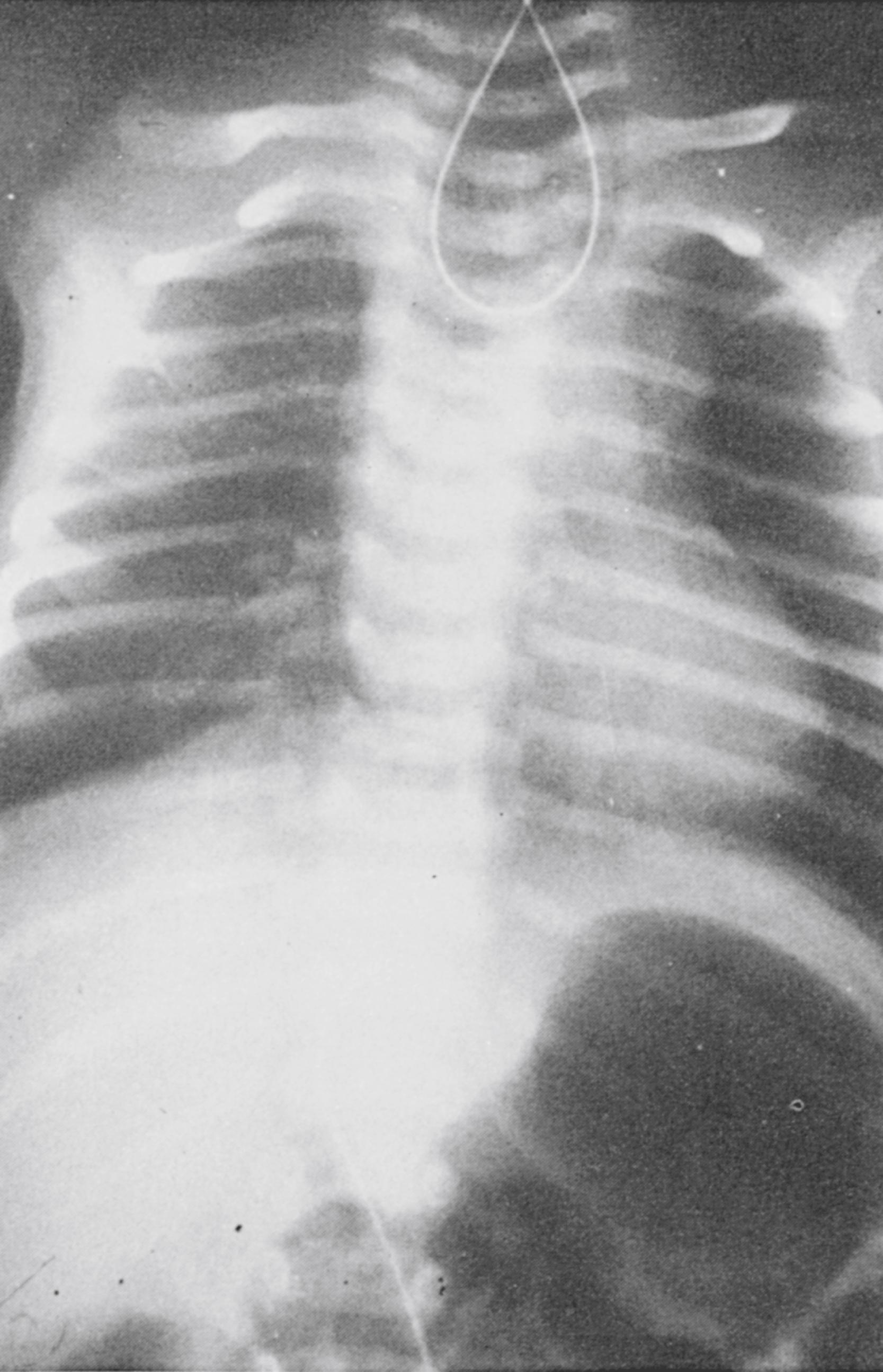
Congenital esophageal stenosis is defined as an intrinsic narrowing of the esophagus present at birth. Infants usually tolerate breast-feeding and start to present with vomiting and regurgitation with the introduction of semisolid or solid food. A milder degree of stenosis may not present until later in childhood. Stenoses are categorized into three histopathologic types: tracheobronchial remnants that often contain cartilage, fibromuscular stenoses, and membranous webs. Contrast radiography can diagnose the first two, while endoscopy is needed to diagnose webs. Tracheobronchial rings generally necessitate surgery, membranous webs can be treated with endoscopic dilation, and muscular stenoses may respond to dilation or may necessitate surgery.
Esophageal strictures ( Fig. 15.4 ) are acquired lesions that can be categorized as inflammatory (secondary to gastroesophageal reflux disease [GERD] and eosinophilic esophagitis), anastomotic (post-TEF repair), or related to corrosive injury (acid, alkali, pills, battery ingestions). The clinical presentation is the same for all these conditions: patients primarily present with dysphagia, recurrent vomiting, or food impaction. The strictures are best demonstrated with contrast radiography; endoscopic biopsies may be important for diagnosis of the etiology. GERD may be treated pharmacologically but may also require an antireflux surgery (fundoplication). Endoscopic dilation of the stricture is performed repeatedly with balloons or semirigid bougies until the strictured site remains patent.
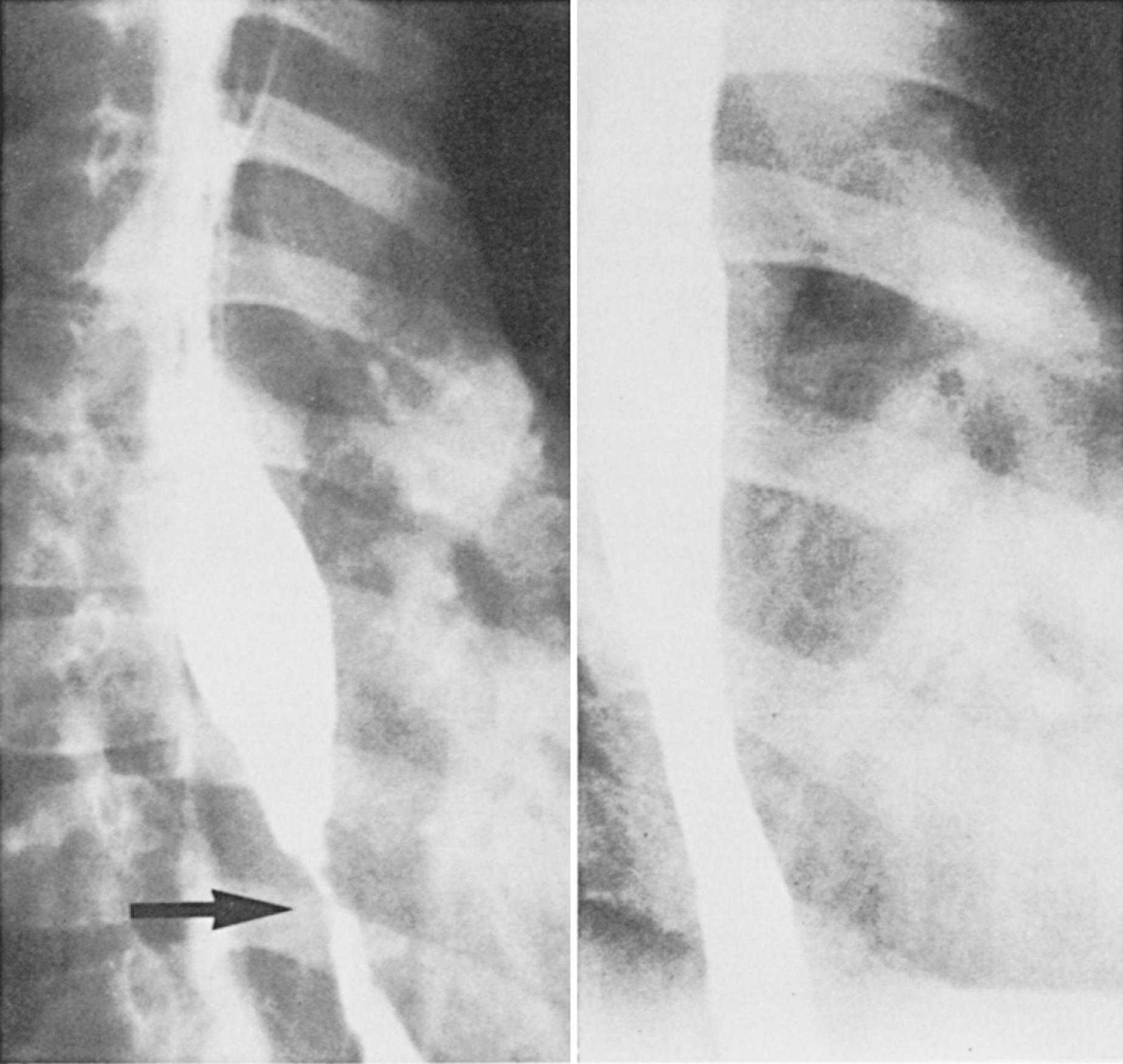
Foreign body ingestion is a common pediatric problem with up to 75% of cases in children age 4 years or younger. Coins are the most commonly ingested foreign body. The esophagus, in particular the upper one third, is a common site for obstruction. Patients may present with drooling, vomiting, cough, and stridor, and if lodged in the esophagus, urgent endoscopic removal is required.
Extrinsic esophageal compression may result from an aberrant subclavian artery, vascular ring, and mediastinal masses (lymphoma, germ cell tumors). Vascular rings occur when the esophagus and trachea are encircled, displaced, or compressed by the aorta or its aberrant branches and can present with stridor, dysphagia, and emesis. It is often an incidental finding on chest x-ray. In symptomatic cases, even after a vascular ring has been detected by plain radiography or esophagography, advanced cross-sectional imaging is recommended for more detailed evaluation.
Hypertrophic pyloric stenosis (HPS) is the most common cause of gastric outlet obstruction in infancy with an incidence rate of 1:400 infants. It manifests with nonbilious projectile vomiting beginning at 2–3 weeks of age and increasing during the next month or so, usually in a first-born male child. The vomitus may rarely contain some blood, and propulsive gastric waves can be seen across the abdominal wall. Dehydration, poor weight gain, hypochloremic hypokalemic metabolic alkalosis, and mild jaundice are sometimes evident. A palpable “olive” in the epigastrium (felt best during or after feeding) represents the hypertrophied pyloric muscle. Gastric distention is seen on the plain film, and a contrast study shows the “string sign” of contrast passing through the narrowed pyloric channel. Ultrasound diagnosis is less invasive and demonstrates increase of the pyloric channel length and muscle thickness ( Fig. 15.5 ). Laparoscopic pyloromyotomy is the treatment of choice. Preoperative correction of dehydration and electrolyte imbalance reduces perioperative morbidity. Junctional epidermolysis bullosum is associated with pyloric stenosis.
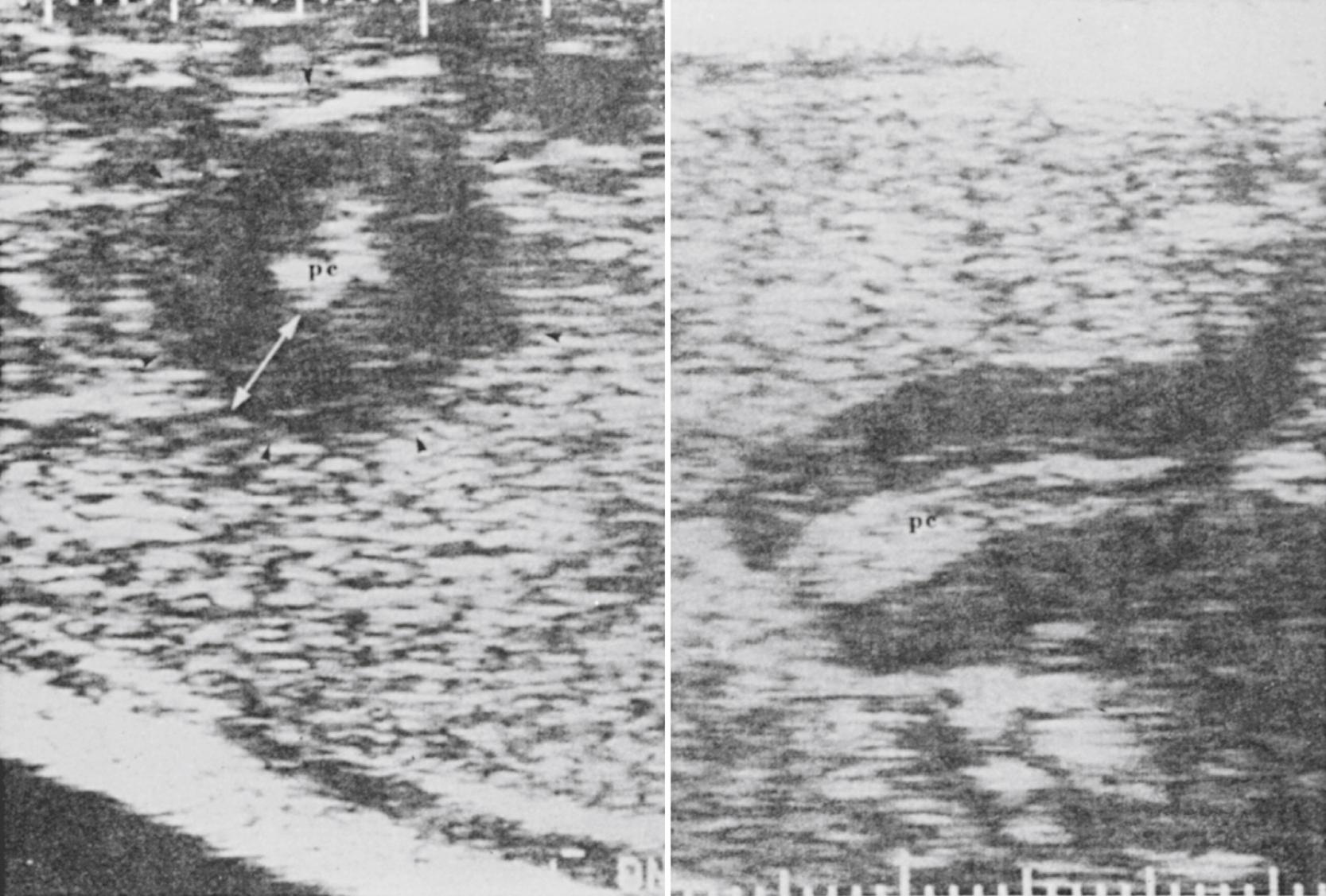
Eosinophilic gastroenteritis can mimic clinical signs and ultrasound appearance of HPS. Clues to diagnosis are eosinophilic infiltrate of endoscopic antral biopsies, peripheral eosinophilia, and an excellent response to treatment with a casein hydrolysate or elemental “hypoallergenic” formula. Prolonged use of prostaglandin infusion in neonates with congenital heart disease may cause transient HPS. The clinical and radiologic features of HPS are relieved after stopping prostaglandin E infusion.
In older children, gastric outlet obstruction may result from chronic peptic ulcer disease, chronic granulomatous disease, gastroduodenal Crohn disease, anatomic abnormalities such as gastric antral web, foreign bodies, and bezoars. Bezoars may be caused by hair, vegetable matter, milk curds, or medications. Contrast radiography, endoscopy, and, in some cases, histopathology is needed to make the diagnosis.
The classical clinical tetrad is colicky abdominal pain, nausea and vomiting, abdominal distention, and constipation-to-obstipation. Examination may demonstrate a tympanic abdomen, hyperactive bowel sounds, and signs of dehydration. Severe direct tenderness, involuntary guarding, abdominal rigidity, and rebound tenderness suggest advanced intestinal obstruction, as do marked leukocytosis, neutrophilia, left shift, and lactic acidosis. Obstructions may be categorized by site and type (see Table 15.10 ). Vomiting is a cardinal sign of intestinal obstruction, being more prominent in high small bowel obstruction than in low small bowel or colon obstruction. With high obstructions, vomiting is not feculent, the onset is often acute, and crampy pain may occur at frequent intervals, while abdominal distention is less prominent. With low obstructions, the vomiting may be feculent and less acute in onset, the interval between cramping is longer, and distention is more notable. Identification of the site of obstruction is aided by the plain film and by other radiographic studies (see Table 15.9 ). Intraluminal lesions (e.g., tumors, intussusceptions, or extrinsic material such as feces, foreign bodies, bezoars, and gallstones) can be differentiated from bowel wall lesions (strictures, stenoses, atresias) and from extraluminal lesions (adhesions, congenital bands, tumors, volvulus) through imaging. Radiographic studies are useful, beginning with the plain film and progressing to ultrasonography or CT. Abdominal CT with oral and intravenous contrast and fluoroscopy with contrast are both sensitive and specific in detecting and characterizing intestinal obstruction. However, the decision to introduce contrast into an intestine that may perforate or be operated on must be made with surgical and radiologic consultation. Often the decision to operate can be made without certain identification of the lesion, and contrast studies are unnecessary.
Infantile bilious vomiting is an important symptom of intestinal obstruction, which often signals a congenital GI anomaly, particularly intestinal obstruction below the ampulla of Vater. Surgical consultation is needed early in these infants because they often require emergency therapy.
The juxta-ampullary duodenum is susceptible to a cluster of obstructing congenital anomalies. Infants with complete duodenal obstruction, most commonly atresia, present with bilious vomiting and a radiographic “double-bubble” sign ( Fig. 15.6 ). Associated prematurity (and polyhydramnios) or anomalies, including renal, cardiac, and vertebral defects, occur in approximately 75% of infants; trisomy 21 is seen in about 50%. Double atresias, duplications, and malrotations are frequently seen. Infants with a partial duodenal obstruction caused by a stenosis or web may have such mild symptoms that they do not come to medical attention until regurgitation produces esophagitis or until a foreign body or bezoar is trapped at the obstruction. Treatment is surgical.
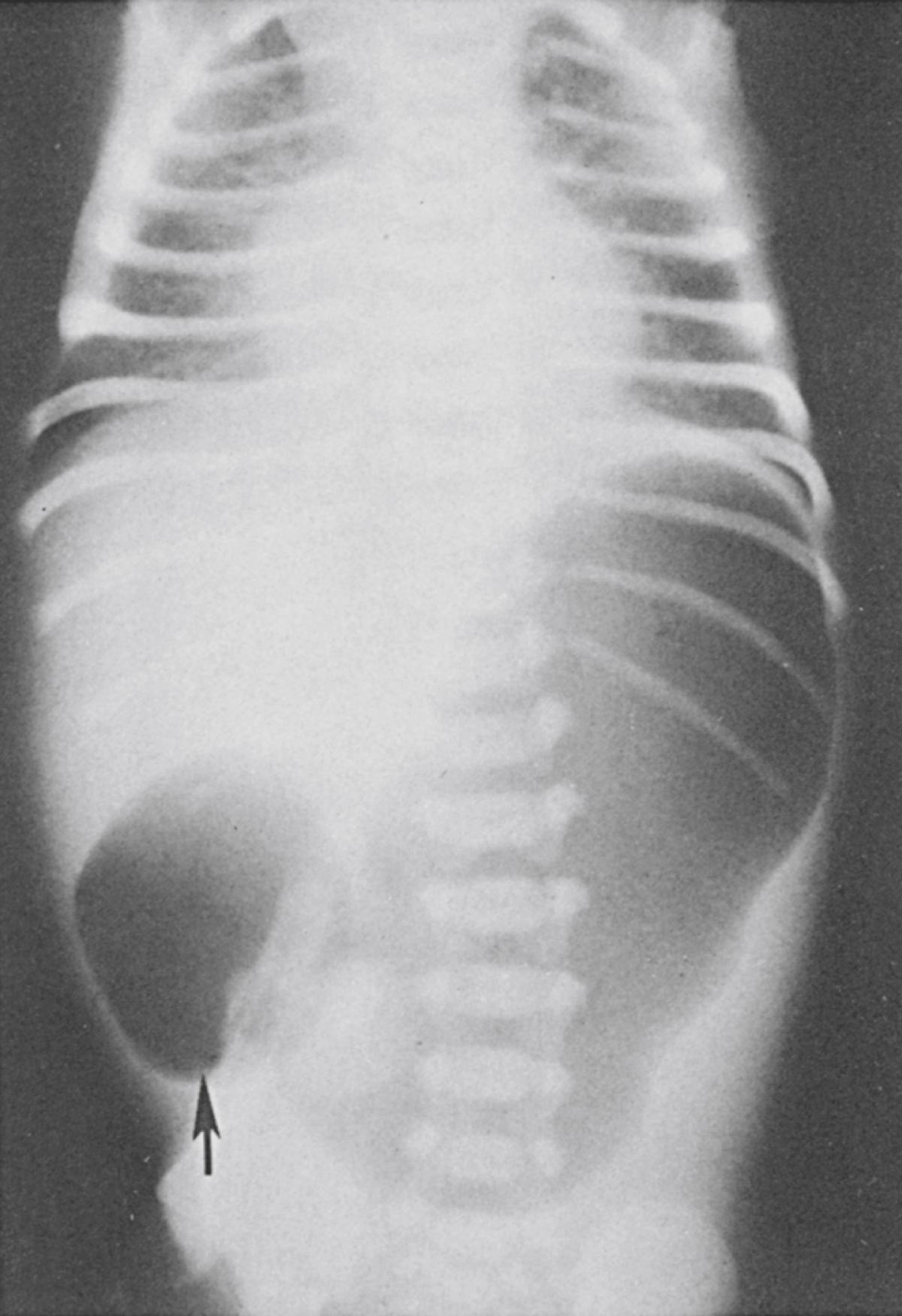
Blunt abdominal trauma (seatbelt, steering wheel, bicycle handlebar injury; child abuse), or even endoscopic biopsies in the context of a coagulopathy, can produce an obstructing duodenal hematoma. Endoscopy in the setting of stem cell transplantation or other hematopoietic disease may place a patient at greater risk of such hematoma, requiring special consideration of the need for duodenal biopsies in these individuals. Therapy is symptomatic; jejunal feeding that bypasses the obstruction or parenteral nutrition may be required as the problem resolves.
Patients with these congenital lesions present with bilious vomiting and more abdominal distention than those with duodenal lesions. The atresias are readily suspected and diagnosed in the neonatal period. Stenotic lesions may require radiography for diagnosis. Treatment is surgical.
Strictures produce partial obstruction of the GI tract and may be located anywhere from the esophagus to the anus. They may occur postsurgically (anastomotic), may follow necrotizing enterocolitis, may be caused by penetrating Crohn disease or intestinal graft versus host disease, or may be sequalae of drug-induced ulcers (nonsteroidal antiinflammatory medications or high-dose pancreatic enzymes). Some patients may be treated with endoscopic dilatation, but many require surgical stricturoplasty (opening the bowel longitudinally and closing it transversely) or resection.
Obstructive symptoms in the child with a history of prior abdominal surgery may be caused by adhesive bands.
GI tract duplication cysts are rare congenital anomalies and can occur in any portion of the GI tract but are more commonly encountered in the small intestine. These uncommon lesions may cause vomiting by extrinsic obstruction of the intestine or by intussusception. On examination, an abdominal mass may be palpable. Treatment is surgical resection.
Approximately 20% of infants with cystic fibrosis present in the newborn period with failure to pass meconium, caused by meconium ileus (MI). The sticky, poorly hydrated intestinal mucus plays a role. It can present in two forms: simple or complex MI. In simple MI, viscid meconium physically obstructs the terminal ileum and results in the dilation of the proximal small intestine. In complex MI, the meconium-distended segments of ileum can give rise to complications like prenatal volvulus, ischemic necrosis, or perforation and extrusion of the meconium into the peritoneum. The classic “soap bubble” sign may be seen on abdominal x-ray when meconium mixes with swallowed air ( Fig. 15.7 ).
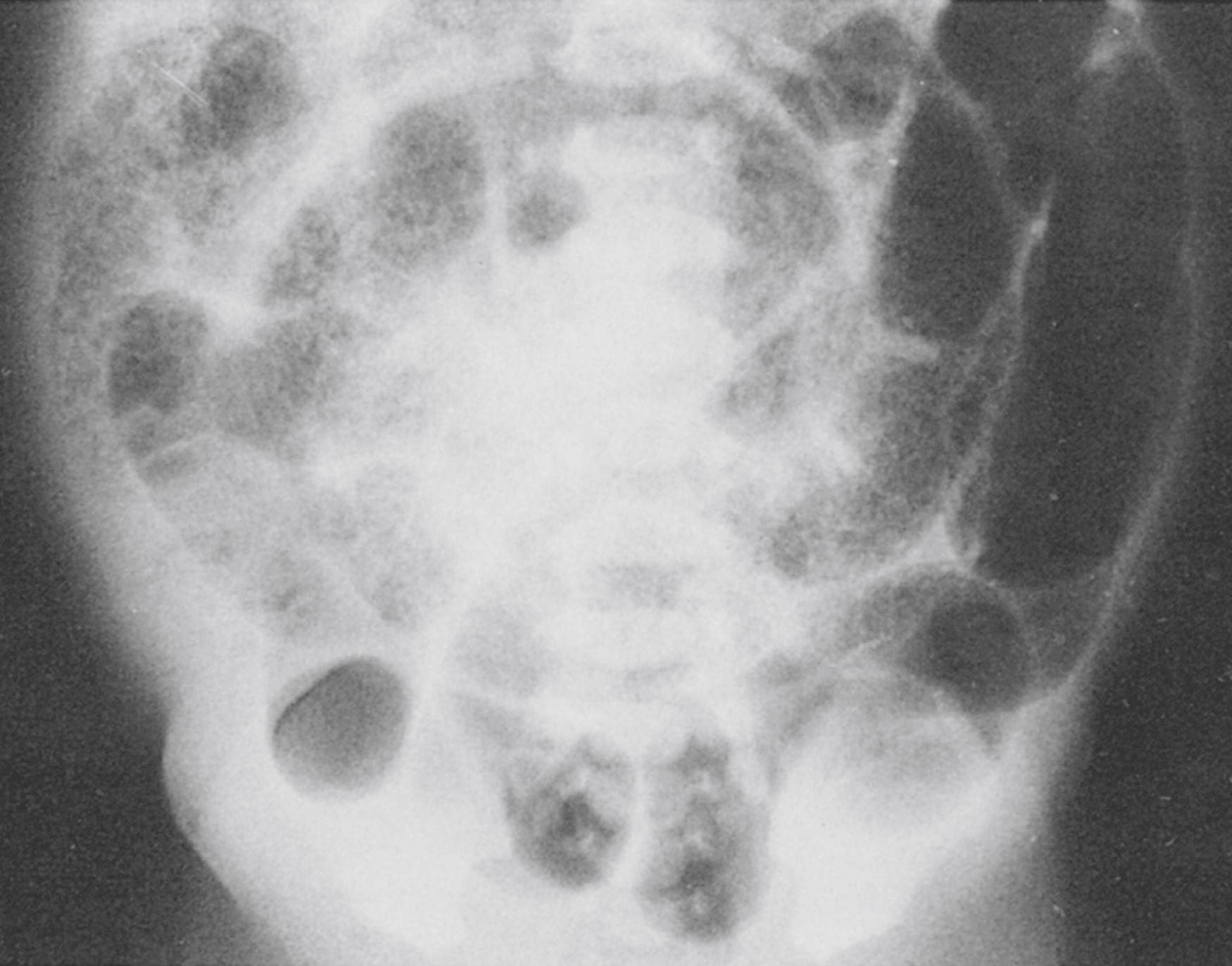
Simple MI may be treated with hyperosmolar contrast (Gastrografin) enema performed under fluoroscopic guidance. Surgery is required for complex MI or those simple cases resistant to enema. Virtually all infants with MI have cystic fibrosis; the diagnosis should be confirmed by sweat test or DNA analysis.
Older children with cystic fibrosis who stop defecating and have abdominal pain and occasional vomiting are said to have distal intestinal obstruction syndrome (DIOS) , formerly termed meconium ileus equivalent. Initial treatment consists of rehydration, stool softening laxatives, or intestinal lavage and enemas. If not successful, then Gastrografin, administered orally or as enema often at times mixed with N-acetylcysteine (mucolytic), is nearly always successful. Surgery is rarely required. Close attention to fluid and electrolyte balance is vital in all infants and children treated with a hyperosmolar contrast medium. Avoiding dehydration and optimizing pancreatic enzyme dosage may reduce the chance of further episodes.
Whenever vomiting is accompanied by signs of obstruction, sites of potential herniation should be examined for incarceration of a loop of bowel ( Fig. 15.8 ). Inguinal incarceration is most common, but other types of hernias are femoral, obturator, spigelian, umbilical (1 in 1,500 incarcerate), epigastric, mesenteric, and postoperative incisional hernias.
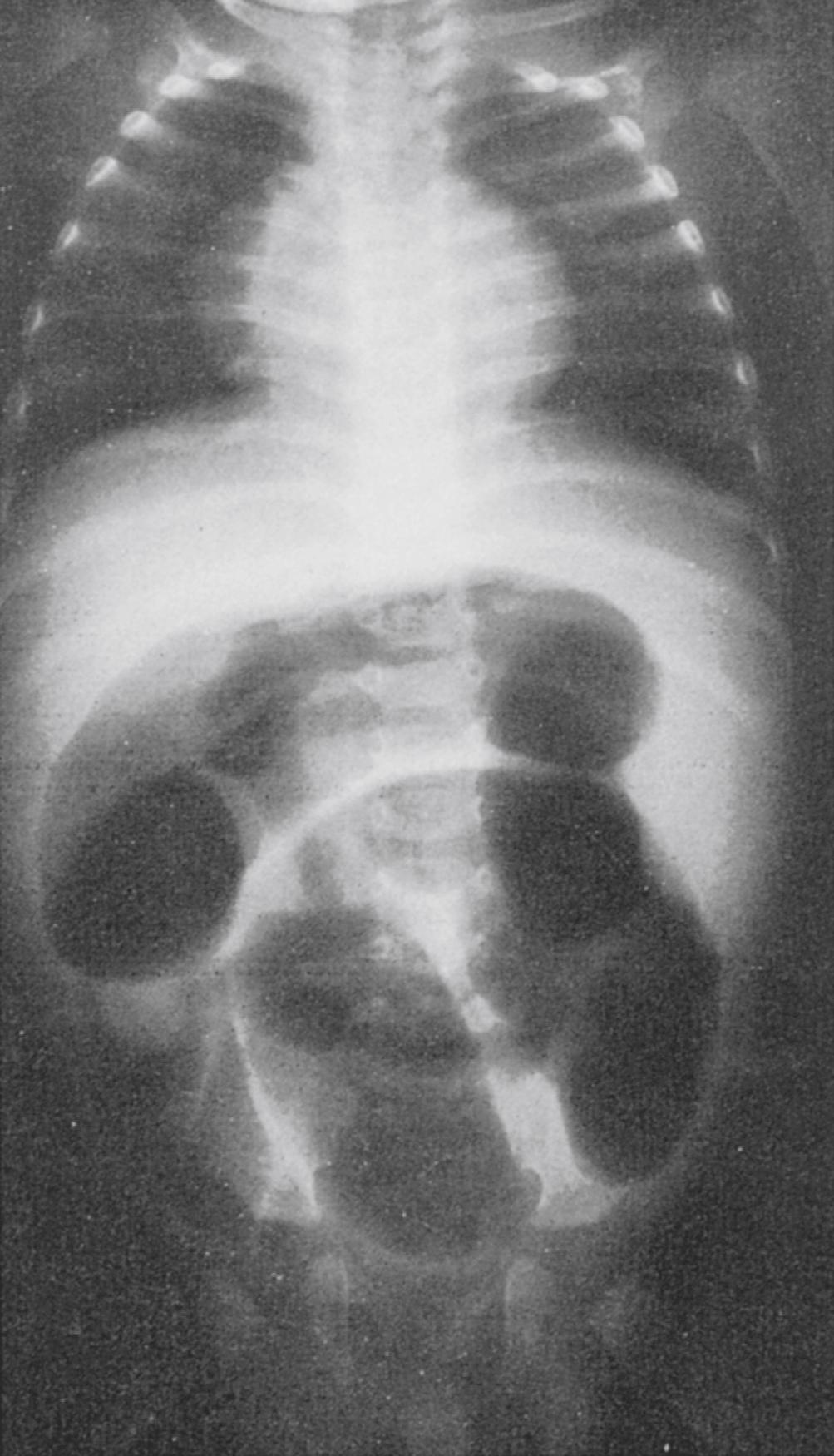
Inguinal hernias are often reduced by gentle, firm, constant pressure that is directed through the scrotum toward the inguinal canal. Sedation and the Trendelenburg position may facilitate reduction.
Volvulus is the twisting of a loop of bowel on the mesentery. Midgut volvulus occurs most often in the context of congenital intestinal malrotation, in which the small intestine is not normally fastened in place. This may only be clinically apparent on upper GI fluoroscopy when the duodenum and distal small bowel are seen to fill with contrast right of midline without crossing to the left upper quadrant ( Fig. 15.9 ). More than half of patients found to have malrotation present symptomatically (the rest of such cases are discovered incidentally), and about half of the symptomatic patients present in the neonatal period with bilious vomiting caused by volvulus. Those presenting later often do not have bilious vomiting; the vomiting may be intermittent for years.
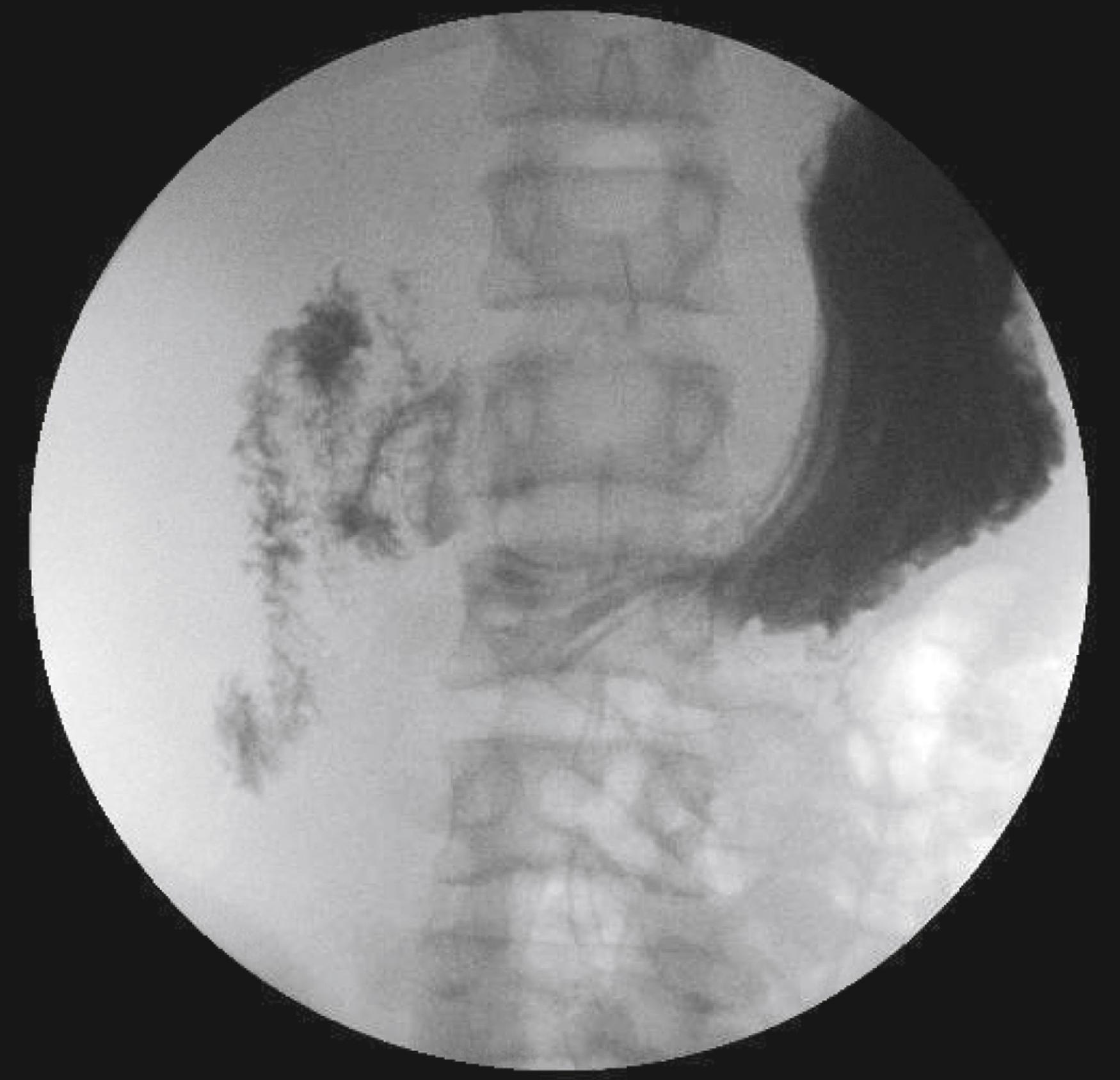
Volvulus is an extremely hazardous obstructing lesion. The luminal obstruction is closed at both ends, which leads to sepsis from rapidly proliferating and translocating bacteria. There is also vascular obstruction caused by the root of the mesentery getting twisted, which quickly produces ischemia of the small intestine. Even if volvulus is diagnosed and repaired promptly, massive intestinal resection may be necessary secondary to underlying necrosis; this produces short bowel syndrome. Because volvulus may be intermittent, it may produce episodic or chronic intermittent vomiting or nonspecific abdominal pain before a lethal event. Therefore, upper intestinal contrast radiographs should be considered in all patients with intermittent vomiting, and surgery must be performed if a malrotation is found (i.e., if the ligament of Treitz is not to the left of the spine), even if volvulus is not present at the time of the examination. In an infant in whom an ongoing volvulus is suspected, a contrast study may show a “volvulus/corkscrew” pattern ( Fig. 15.10 ). In the sick infant or child in whom volvulus seems likely, surgery without contrast studies may be preferred. Surgery involves correction of any present volvulus, functional positioning of malrotation, and lysis of potentially obstructing peritoneal (Ladd) bands that cross the abdomen.
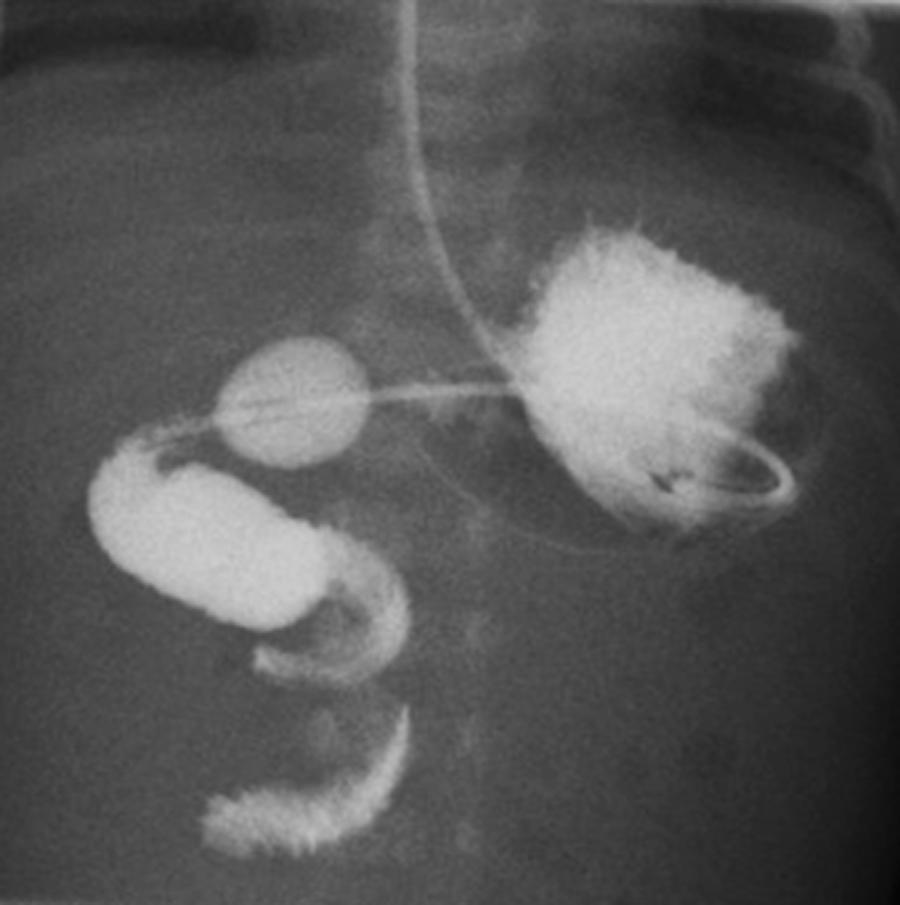
Other types of volvulus not associated with malrotation include cecal, sigmoid, and transverse colonic volvulus. They are less common in children and less apt to produce short bowel syndrome, but they too may manifest with vomiting and result in death if untreated. Sigmoid volvulus is sometimes treated nonoperatively via endoscopic release.
Meckel diverticulum is a small intestinal diverticulum that represents the fibrous remnant of the omphalomesenteric duct. Although painless GI bleed is the most common presentation, it can present as intestinal obstruction or inflammation (diverticulitis). It may lead to obstructive vomiting by causing intussusception ( Fig. 15.11 ) or intestinal volvulus around the diverticular axis. It can get inflamed, leading to peritonitis (mimics appendicitis or peptic ulcer disease) and sometimes perforation, which can induce vomiting. The “rule of 2s” identifies characteristic findings: diverticula are present in 2% of the population; only 2% are symptomatic; the male:female ratio is 2:1; the diverticula occur within 2 feet of the ileocecal valve and are 2 inches long; there are 2 major types of heterotopic mucosa (gastric and pancreatic); and the condition is confused with 2 diseases (appendicitis and peptic ulcer). Treatment is surgical resection.
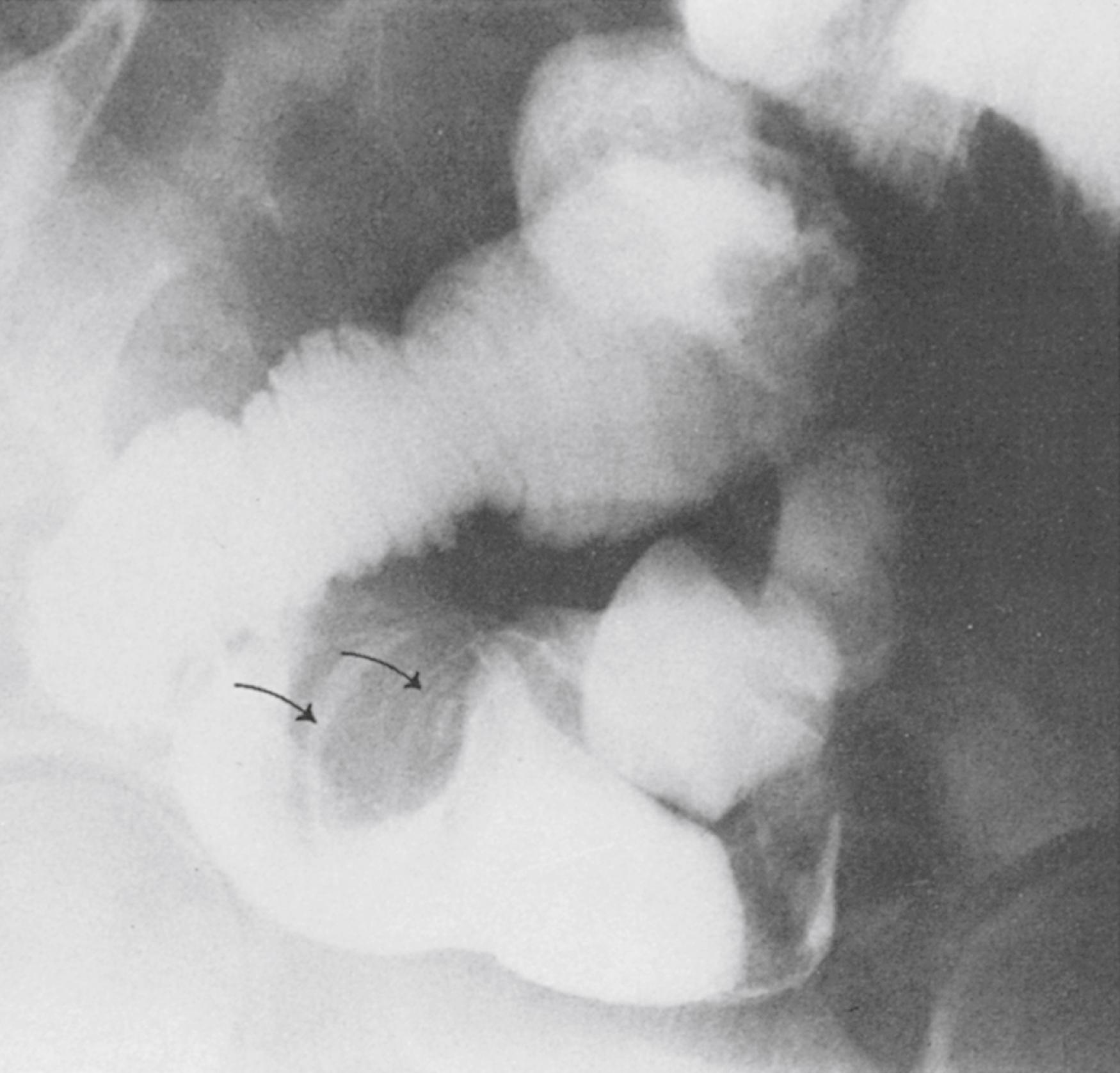
Become a Clinical Tree membership for Full access and enjoy Unlimited articles
If you are a member. Log in here